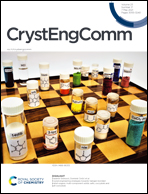Cu2O nanoparticle-catalyzed synthesis of diaryl tetrazolones and investigation of their solid-state properties†
Abstract
An efficient and versatile method for the synthesis of 1,4-diaryl tetrazolones 1 is reported which involves C–N coupling of aryl tetrazolones 2 with aryl boronic acids 3 in the presence of Cu2O nanoparticles under an oxygen atmosphere and DMSO as solvent. The reaction tolerates a variety of electron donating and electron withdrawing substituents on both substrates and produces the desired 1,4-diaryl tetrazolones 1 in moderate to good yields. In the crystal lattice, the molecules exhibit π⋯π stacking interactions between the adjacent layers as well as weak through-space electrostatic C–H⋯O interactions involving the pendant rings and tetrazolone carbonyl. 1-(4-Methoxyphenyl)-4-(3-tolyl)-1,4-dihydro-5H-tetrazol-5-one 1bk and 1-(3-fluorophenyl)-4-(4-methoxyphenyl)-1,4-dihydro-5H-tetrazol-5-one 1be, differing only in the presence of one group (methyl or fluoro), exhibited an identical pattern of noncovalent interactions in the solid-state. Hirshfeld surface analyses have also been performed to visualize intermolecular interactions.

- This article is part of the themed collection: Supramolecular & Polymorphism


 Please wait while we load your content...
Please wait while we load your content...